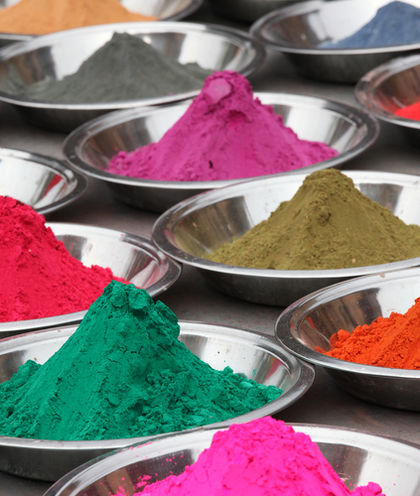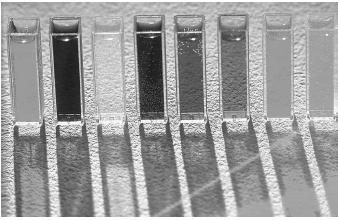Dyes

The great appeal of textiles lies in their colors and the way that color is used to create patterned effects. Color is applied by the process of dyeing, which in its simplest form involves the immersion of a fabric in a solution of a dyestuff in water. Patterned effects are obtained by selectively applying dyes to fabric, for example by roller printing. The amount of dyestuff required is very small, but its production and application require considerable skill. Changes in the ways of producing dyes during the nineteenth century heralded the modern science-based chemical industry.
Natural Dyes
Dyes obtained from natural products, such as plants and insects, have been used for decorative effect and as symbols of status for thousands of years. The mollusk-derived Roman purple, 6,6′-dibromoindigo, also called Tyrian purple, was remarkable for its fastness to light and washing; it was also an important mark of social distinction. The associated biblical blue holds great religious significance among observant Jews. In China, the emperor and empress wore yellow, the imperial ladies violet, and noblemen of the first grade blue. Explorers of the Americas came across many natural dyes, particularly dyewoods, not previously known in Europe. Native American peoples, such as Navajo and Hopi, were highly skilled dyers. In Europe the blue extracted from the woad plant was used for adornment, through the coloring of skin and later the dyeing of textiles.
By the sixteenth century dyes played a major role in political and economic history as European nations vied for sources of new colors and the secrets of applying natural colors. Indigo tinctoria that yielded a brighter indigo blue than woad arrived in Europe from India and the East. Indigo and the red known as madder, from the roots of the madder plant, were the most important natural dyes. Indigo was used in kimono dyeing in Japan. Madder was the basis of the fiery Turkey red. England's King George II chose indigo for the color of British naval uniforms (hence "navy blue").
Indigo is a vat dye, which means that it was once applied in special vats. It and other vat dyes are insoluble in water. In dyeing, indigo is converted, or reduced, to a white form, which is soluble. Yarn or fabric is then dipped in the vat containing the reduced dye, which on leaving the vat is oxidized in the air back to blue. Tyrian purple and biblical blue are also vat dyes.
Dyes, Industry, and Science
Dyestuffs were central to the first Industrial Revolution , from the late eighteenth century, based on the production of and trade in textiles. This

encouraged chemists to investigate the composition of natural dyes. They extracted the colorant in madder and gave it the scientific name alizarin. Dyes also played a prominent role in the second Industrial Revolution, commencing around 1870, when the quest for synthetic colorants led to the development of science-based industry.
The first of the modern synthetic dyes was invented in London in 1856 by the chemist William Henry Perkin when he was still a teenager. His product was first sold as Tyrian purple, but from 1859 on it was known as mauve, from the French word for the mallow flower. It was made from coal tar, the waste product of the coal gasification process. The coal-tar product benzene was converted in three steps to the dye. Perkin's teacher was the German chemist August Wilhelm Hofmann, who began research to identify the chemical constituents of the new coal-tar or "aniline" dyes. Chemistry in Germany was highly developed at this time, and many Germans journeyed to England to work in the new synthetic dye industry. Starting in the mid-1860s, they returned home, armed with the latest science and technology. The industry soon moved to Germany and Switzerland.
Particularly significant was the production of artificial alizarin red (in 1869), mainly in Germany, and indigo (1897), only in Germany. These synthetic products destroyed the trading monopolies in natural dyes by displacing the large-scale cultivation of madder and indigo. The other new dyes had no analogs in nature. In 1875 the dye chemist Otto N. Witt proposed a theory of color and constitution that is still used to explain how certain arrangements of atoms, called chromophores , give rise to color. Other groups called auxochromes enable the bonding to fiber and modify the color.
The development of the synthetic dye industry led to the emergence of classical organic chemistry. Its application in industry was rapid. From the end of the nineteenth century the intermediates employed in the manufacture of synthetic dyes were used to make pharmaceutical products such as aspirin. Some synthetic dyes exhibited bactericidal properties; they were called medicinal dyes. Sulfonamides , drugs introduced in the 1930s, are based on research into dyestuffs and their intermediates. Less fast dyes have made color photography possible. Indigo is not fast to light and washing, and soon gives a faded effect. Since the 1960s that property has been used to advantage in fashionable denims.
The modern U.S. chemical industry emerged in 1915, when supplies of dyes were cut off by Germany, which required dyes and their intermediates for military purposes, including the manufacture of explosives, and also by the British blockade on German shipping. From the 1970s the by then mature industry declined in Europe and the United States, in part because of environmental difficulties facing dye manufacturers, such as the pollution of surface waters.
Making Colors Last
Color fastness is important in textiles. It is a measure of how well the dye is attached to fabric (substrate). In the early 1900s a new class of coal-tar dyes, known as the indanthrenes, was invented. Some blue indanthrenes displaced indigo, because they were faster to light and washing, and brighter. The most important of these colorants, collectively known as vat dyes, is vat jade green.
Mordant dyes are those that can be applied only with a fixing agent, or mordant. The fixing agents are often metal compounds, particularly those whose cations form coordination complexes. Alizarin is a mordant dye, and with different metal compounds it gives a range of colors. The first synthetic dyes that attached to fabric without the need for a mordant were benzidine dyes, invented in the 1880s. However, early in the twentieth century some of them were found to cause bladder cancer. Their manufacture ceased by the early 1970s. In 1956 chemists at Imperial Chemical Industries (ICI) in England announced the first dyes that bonded chemically to fabric; these fiber-reactive colorants ensured great fastness.
Common Dyes
Fluorescent dyes, or whitening agents, alter the drab gray or yellow appearance of white fabrics that have been washed many times. They do this by absorbing ultraviolet (UV) light and reemitting the absorbed energy as fluorescence in the blue region of the spectrum. This "blueing" makes fabrics look whiter and brighter. Fluorescent dyes are also used as tracers in following sewage and contaminated sources of water, and are important in detection chemistry for drug development.
A wide variety of natural and synthetic dyes are used to color foodstuffs. Florida oranges, often a natural green color when ripe, are sometimes dyed orange with synthetic dyes. Since some synthetic dyes cause illness, their use is restricted, or excluded, even in the coloration of textiles. In the United States, the Pure Food, Drug, and Cosmetic Act enables the Food and Drug Administration (FDA) to control the dyes in foods. This is why these dyes are given names with the prefix FD&C or External D&C.
Hair dyes are of two types: permanent and semipermanent. Permanent dyeing is achieved with a synthetic dye, applied with hydrogen peroxide that first bleaches the natural pigment melanin. Semipermanent dyes are generally made with vegetable extracts, such as henna, that coat rather than penetrate the hair shaft. There are a number of questions about the safety of synthetic hair dyes, since some of the products they contain cause cancer.
Easter egg dyes are natural dyes that can be found around the home. They include blue from cabbage leaves or blueberries, orange from yellow onion skins, red from cranberries or raspberries, pale green from spinach leaves, and light yellow from orange or lemon peels. Dyes often have different colors in acidic and alkaline solutions. This enables them to be used as acid-base indicators. Many dyes are utilized as biological stains .
TIE-DYEING
Tie-dyeing is, like textile printing, selective dyeing. If a piece of wool is bound tightly with cotton strips and then dyed by immersion in a dye bath, only those areas exposed to the dye will take on its color. After the fabric is removed and allowed to dry, and when the strips of cotton are untied, the tightly bound areas show no color from the dye. Omitting dye from an area creates what is referred to as a reserve. The whole piece can then be placed in a dye bath, so that the reserve areas are now dyed, and the previously dyed areas show the effect of two dyes. This process, called tie-dyeing, creates interesting patterns on fabric and is often used in producing T-shirts, shorts, or handkerchiefs.
SEE ALSO Cosmetics ; Perkin, William Henry ; Pigments .
Anthony S. Travis
Bibliography
Bearfoot, Will (1975). Dyes and Fibers. Willits, CA: Oliver Press.
Brunello, Franco (1973). The Art of Dyeing in the History of Mankind. Vicenza: Neri Pozza Editore.
Cannon, John, and Cannon, Margaret (1994). Dye Plants and Dyeing. London: Herbert Press.
Epp, Dianne N. (1995). Palette of Color Series: The Chemistry of Natural Dyes ; The Chemistry of Vat Dyes ; The Chemistry of Food Dyes. Middletown, OH: Terrific Science Press.
Fox, Robert, and Nieto-Galan, Agustí, eds. (1999). Natural Dyestuffs and Industrial Culture in Europe, 1750–1880. Nantucket, MA: Science History Publications.
Garfield, Simon (2001). Mauve: How One Man Invented a Color That Changed the World. New York: W.W. Norton.
McGrayne, Sharon Bertsch (2001). Prometheans in the Lab: Chemistry and the Making of the Modern World. New York: McGraw-Hill.
Robinson, Stuart (1968). A History of Dyed Textiles: Dyes, Fibres, Painted Bark, Batik, Starch-Resist, Discharge, Tie-Dye, Further Sources for Research. Cambridge, MA: MIT Press.
Robinson, Stuart (1969). A History of Printed Textiles: Block, Roller, Screen, Design, Dyes, Fibres, Discharge, Resist, Further Sources for Research. Cambridge, MA: MIT Press.
Shultz, Kathleen (1982). Create Your Own Natural Dyes. New York: Sterling Publishing.
Travis, Anthony S. (1991). "Synthetic Dyestuffs: Modern Colours for the Modern World." In Milestones in 150 Years of the Chemical Industry, ed. P. J. T. Morris, W.A. Campbell, and H. L. Roberts. London: Royal Society of Chemistry, pp. 144–157.